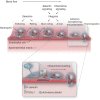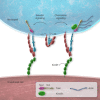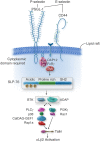Selectins: initiators of leucocyte adhesion and signalling at the vascular wall
- PMID: 25994174
- PMCID: PMC4592324
- DOI: 10.1093/cvr/cvv154
Selectins: initiators of leucocyte adhesion and signalling at the vascular wall
Abstract
The selectins are transmembrane, Ca(2+)-dependent lectins that mediate leucocyte rolling on vascular surfaces, the first adhesive step during inflammation and immune surveillance. Leucocytes express L-selectin, activated platelets express P-selectin, and activated endothelial cells express E- and P-selectin. Rolling involves force-regulated, rapidly reversible interactions of selectins with a limited number of glycosylated cell surface ligands. Rolling permits leucocytes to interact with immobilized chemokines that convert β2 integrins to high-affinity conformations, which mediate arrest, post-arrest adhesion strengthening, and transendothelial migration. However, rolling leucocytes also transduce signals through selectin ligands, the focus of this review. These signals include serial activation of kinases and recruitment of adaptors that convert integrins to intermediate-affinity conformations, which decrease rolling velocities. In vitro, selectin signalling enables myeloid cells to respond to suboptimal levels of chemokines and other agonists. This cooperative signalling triggers effector responses such as degranulation, superoxide production, chemokine synthesis, and release of procoagulant/proinflammatory microparticles. In vivo, selectin-mediated adhesion and signalling likely contributes to atherosclerosis, arterial and deep vein thrombosis, ischaemia-reperfusion injury, and other cardiovascular diseases.
Keywords: Cell adhesion; Inflammation; Integrin; Neutrophil; Selectin.
Published on behalf of the European Society of Cardiology. All rights reserved. © The Author 2015. For permissions please email: journals.permissions@oup.com.
Figures



References
-
- Ley K, Laudanna C, Cybulsky MI, Nourshargh S. Getting to the site of inflammation: the leukocyte adhesion cascade updated. Nat Rev Immunol 2007;7:678–689. - PubMed
-
- Nourshargh S, Hordijk PL, Sixt M. Breaching multiple barriers: leukocyte motility through venular walls and the interstitium. Nat Rev Mol Cell Biol 2010;11:366–378. - PubMed
-
- Kahn J, Walcheck B, Migaki GI, Jutila MA, Kishimoto TK. Calmodulin regulates L-selectin adhesion molecule expression and function through a protease-dependent mechanism. Cell 1998;92:809–818. - PubMed
-
- Yao L, Setiadi H, Xia L, Laszik Z, Taylor FB, McEver RP. Divergent inducible expression of P-selectin and E-selectin in mice and primates. Blood 1999;94:3820–3828. - PubMed
Publication types
MeSH terms
Substances
Grants and funding
LinkOut - more resources
Full Text Sources
Other Literature Sources
Miscellaneous

